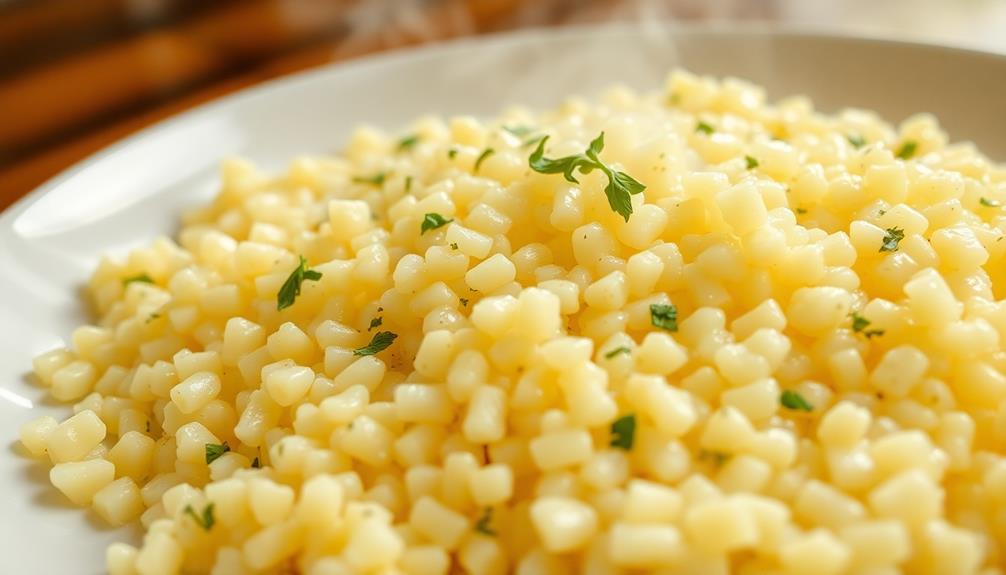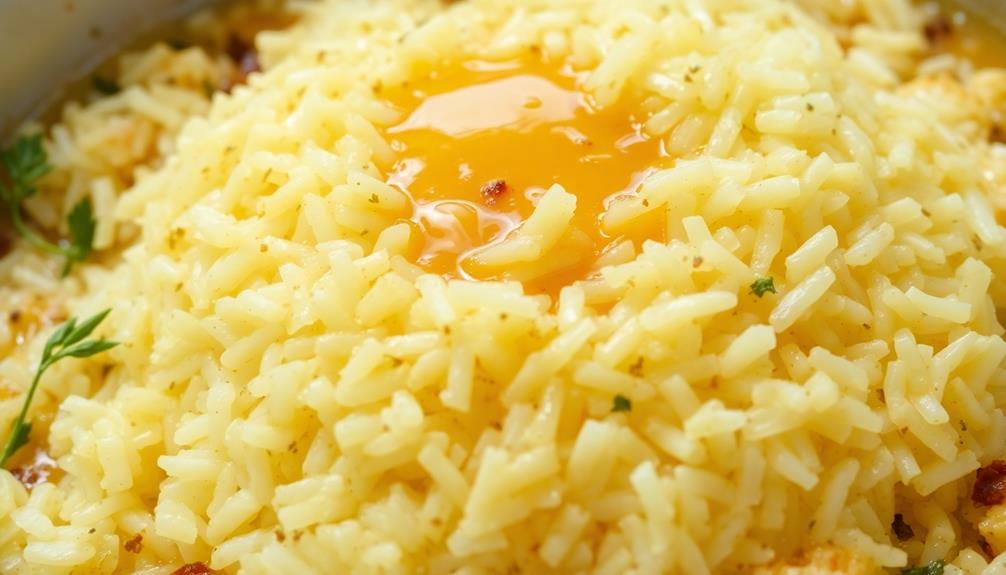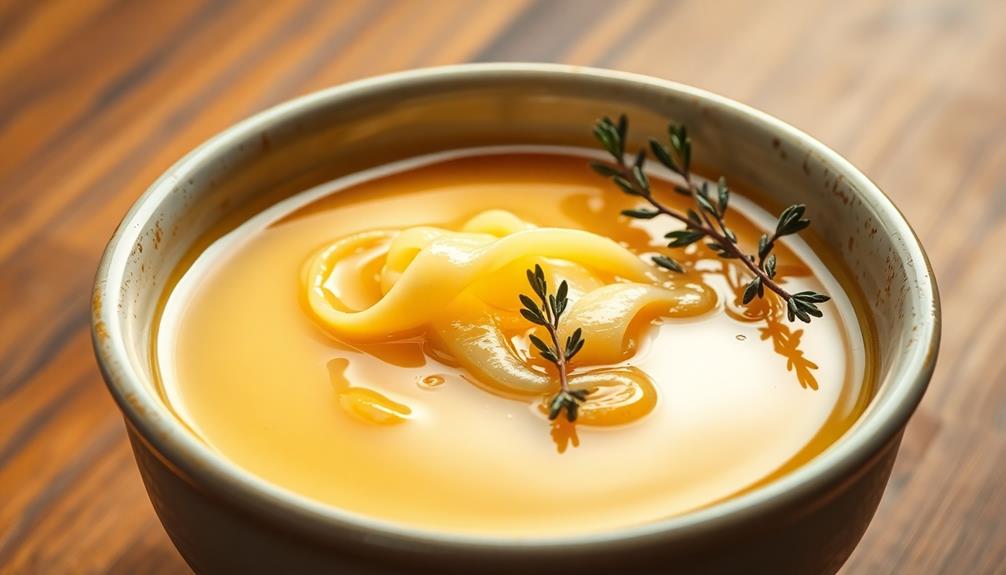Moroccan butter couscous is a delightful, light and fluffy side dish that'll whisk you away to the vibrant markets of Morocco. The classic North African staple is infused with a rich, creamy butter twist, creating a harmonious balance of flavors and textures. Fragrant spices like cinnamon and cumin enhance the dish, while the fluffy couscous melts in your mouth, leaving a lingering buttery taste. It's the perfect companion to grilled meats, hearty stews, and vegetable-based dishes, elevating any meal with its aromatic flair. Explore the cultural heritage and culinary traditions of Morocco through this versatile and comforting couscous creation.
Key Takeaways
- Moroccan Butter Couscous is a traditional North African dish featuring a light, fluffy couscous base enhanced with a rich, creamy butter flavor.
- The preparation involves steaming couscous to achieve a tender, cloud-like texture and then incorporating fragrant spices like cinnamon and cumin for a harmonious flavor profile.
- This versatile dish pairs well with a variety of proteins, vegetables, and stews, making it a versatile and accessible accompaniment for both casual and formal meals.
- Moroccan Butter Couscous represents the cultural significance of couscous in North African cuisine, reflecting the vibrant culinary heritage and traditions of the region.
- The simple cooking process and minimal ingredients required make Moroccan Butter Couscous an easy-to-prepare side dish that can elevate everyday meals with its indulgent, buttery essence.
History
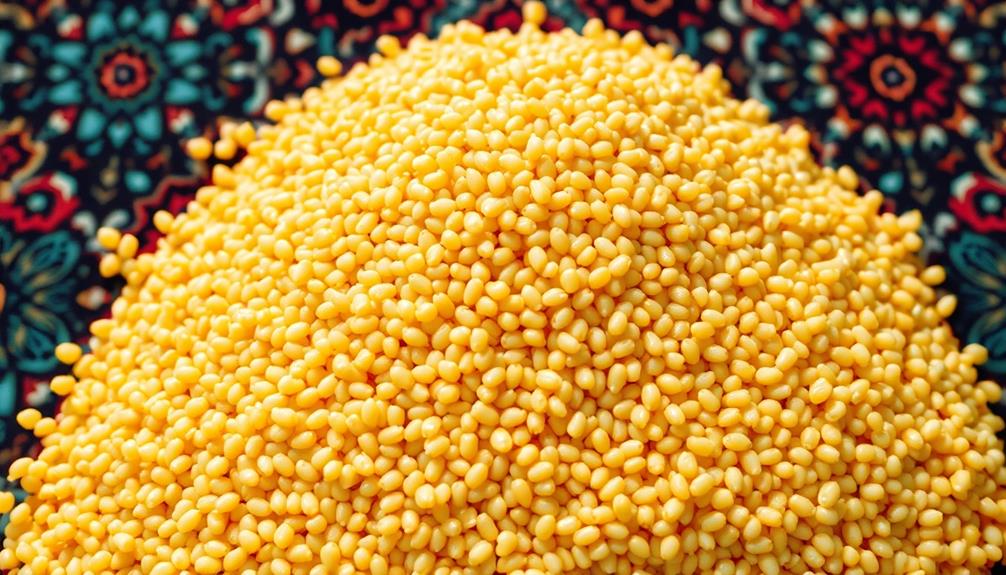
Couscous, a staple food in North African cuisines, has a rich history dating back centuries. This tiny, pearl-like pasta has been a dietary staple for the people of Morocco, Algeria, and Tunisia for generations.
Traditionally, couscous was made by hand, with women meticulously rolling and steaming the semolina flour to create the perfect texture. Over time, this labor-intensive process evolved, and today, couscous is often prepared using modern kitchen appliances.
However, the traditional methods are still practiced in many Moroccan households, preserving the cultural significance and unique flavor of this beloved dish.
Whether handmade or store-bought, couscous remains a cornerstone of North African cuisine, reflecting the region's vibrant culinary heritage. Its versatility allows it to be enjoyed in a variety of preparations, from savory stews to sweet desserts, making it a beloved staple in Moroccan kitchens and beyond.
Recipe

Couscous is a staple in Moroccan cuisine, and Moroccan Butter Couscous is a delightful variation that showcases the depth of flavors this simple grain can achieve. The key to this dish lies in the careful preparation of the couscous, which is steamed to perfection, and the rich, aromatic butter that infuses it with a comforting, indulgent quality.
To begin, the couscous is gently steamed, allowing the grains to become tender and fluffy. This steaming process is essential in creating the light and airy texture that distinguishes Moroccan-style couscous from its denser counterparts. The addition of fragrant spices, such as cinnamon and cumin, lend a depth of flavor that transports the dish to the vibrant markets of Marrakech.
Ingredients:
- 1 cup couscous
- 1 1/2 cups water
- 1/4 cup unsalted butter
- 1 teaspoon ground cinnamon
- 1/2 teaspoon ground cumin
- 1/4 teaspoon salt
Instructions:
In a medium saucepan, bring the water to a boil. Add the couscous, cover, and remove from heat. Let the couscous steam for 5-7 minutes, or until the grains are tender and fluffy.
In a separate pan, melt the butter over medium heat. Add the cinnamon, cumin, and salt, and stir to combine. Fluff the cooked couscous with a fork and drizzle the spiced butter over the top, gently mixing to coat the grains evenly.
When serving Moroccan Butter Couscous, consider pairing it with grilled or roasted meats, such as chicken or lamb, to create a harmonious and satisfying meal. The light, fragrant nature of the couscous also makes it an excellent accompaniment to vegetable-based dishes, allowing the flavors to complement each other perfectly.
Cooking Steps

Let's get started on the Moroccan Butter Couscous! First, you'll bring the couscous and water to a boil. For optimal results, consider using a heat pump for energy efficiency while cooking.
Then, fluff that couscous with a fork to keep it light and fluffy. Next, stir in the butter and seasonings until everything's nicely combined.
Step 1. Bring Couscous and Water to Boil

Next, bring the water-couscous mixture to a boil over high heat.
You'll see the water start to bubble and steam will begin rising from the pot. This is the perfect time to give the mixture a quick stir with a wooden spoon, just to make sure the couscous isn't sticking to the bottom.
Once it reaches a full boil, reduce the heat to low and let it simmer for about 5 minutes.
During this time, the couscous will slowly absorb all the flavorful water, plumping up into soft, fluffy grains. Keep an eye on it, giving it an occasional gentle stir, until the couscous is tender and the liquid is fully absorbed. This should take roughly 5 minutes.
Now that your couscous is perfectly cooked, it's time to fluff it with a fork and get ready for the next step – adding the delicious, melted butter!
Step 2. Fluff Couscous With a Fork
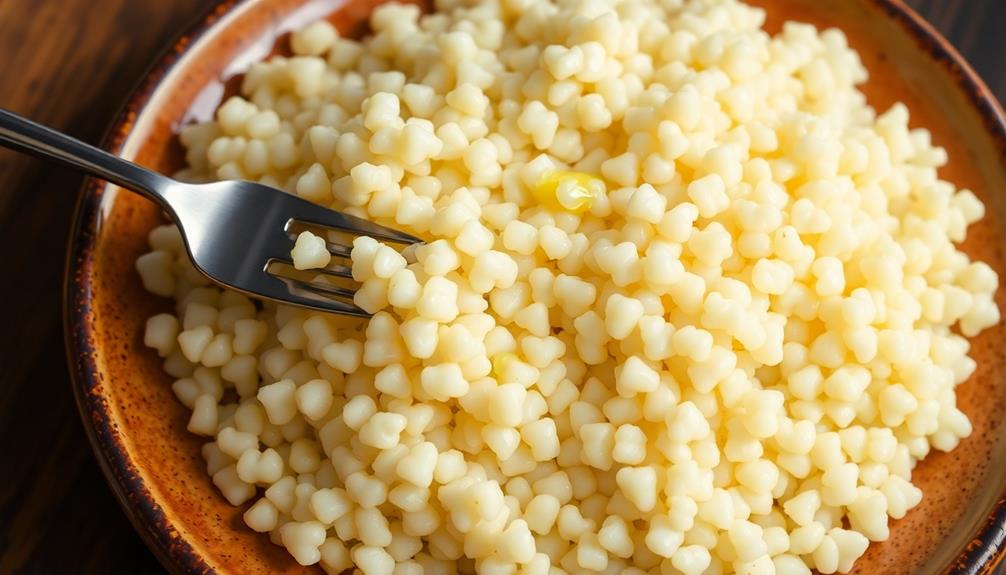
Once the couscous has finished simmering and absorbed all the liquid, it's time to fluff it.
Grab a fork and gently run it through the grains, separating and loosening them up. You'll see the couscous transform from a compact, sticky mass into light, fluffy perfection.
Be careful not to overwork it, as that can make the texture heavy and dense. Instead, use a light touch, lifting and turning the couscous with the tines of the fork.
This airy, fluffed texture is key to achieving the signature Moroccan style. As you fluff, you'll notice the grains becoming more distinct and the overall volume increasing.
This step is essential for creating the perfect bed for your hearty stews, fragrant tagines, or simply as a light and fluffy side dish.
Keep gently fluffing until you've achieved the desired light and airy texture.
Step 3. Stir in Butter and Seasonings
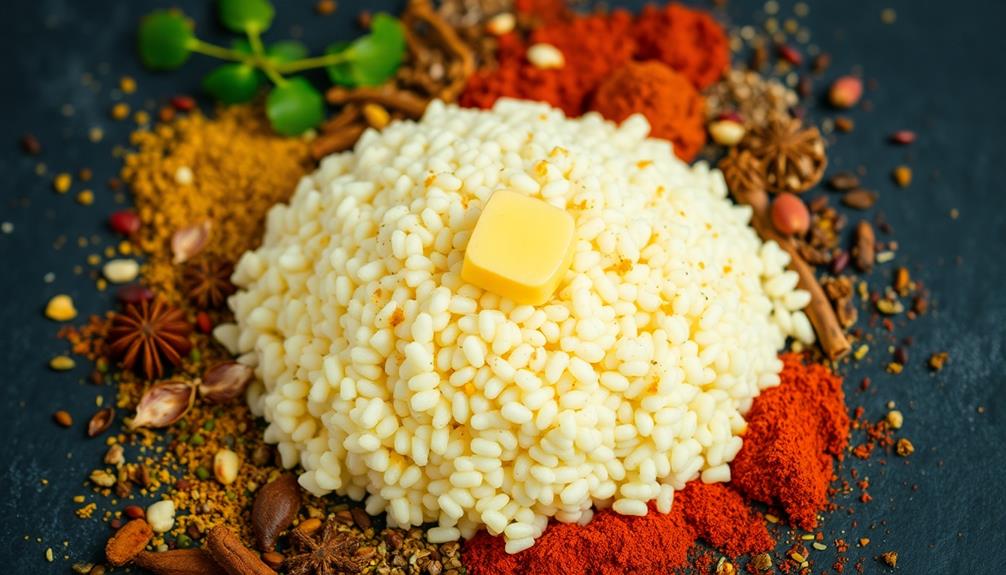
After fluffing the couscous, stir in a generous amount of butter. You'll want to use around 2 tablespoons for every cup of cooked couscous. The butter will melt right into the warm, fluffy grains, coating each one and giving the dish a rich, creamy texture.
Don't be shy with the butter – it's what gives this Moroccan-inspired side its signature flavor!
Next, add a dash of salt and pepper to taste. The salt enhances the buttery notes, while the pepper gives a subtle heat and complexity. For extra flavor, consider stirring in a sprinkle of cumin, cinnamon, or paprika. These warm spices pair beautifully with the butter, creating a depth of flavor that transports you to the bustling markets of Marrakech.
Keep stirring the couscous until the butter is fully incorporated and the seasonings are evenly distributed. The result should be a light, fluffy bed of couscous infused with a luxurious, buttery essence.
Serve hot, allowing your guests to savor each buttery, fragrant bite.
Step 4. Cover and Let Stand
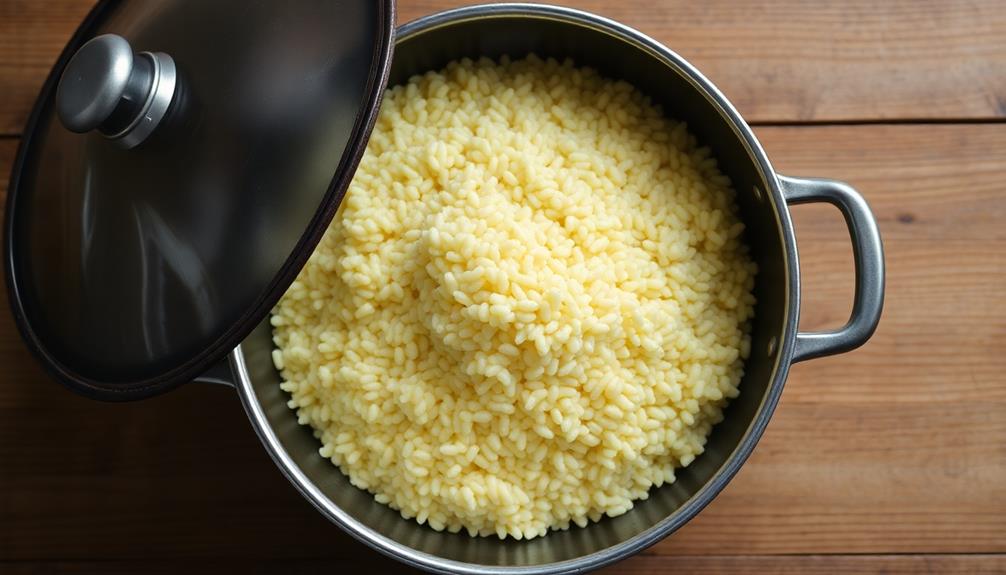
With the butter and seasonings now incorporated, cover the couscous and let it stand for 5-10 minutes. This brief rest period allows the flavors to meld and the couscous to fully absorb the liquid.
You'll notice the grains softening and plumping up during this time. The cover traps the heat, gently steaming the couscous to a light and fluffy texture.
As it sits, the aromas of the fragrant spices and warm butter will begin to waft through your kitchen, tantalizing your senses and building anticipation for the first delicious bite.
Resist the temptation to lift the lid and peek – this resting time is crucial for achieving the perfect Moroccan-style couscous.
When the timer goes off, uncover the pot and fluff the couscous with a fork. It's now ready to serve as a wonderfully flavored side dish, complementing your main course with its buttery richness and delicate, light-as-air grains.
Step 5. Fluff Couscous With a Fork
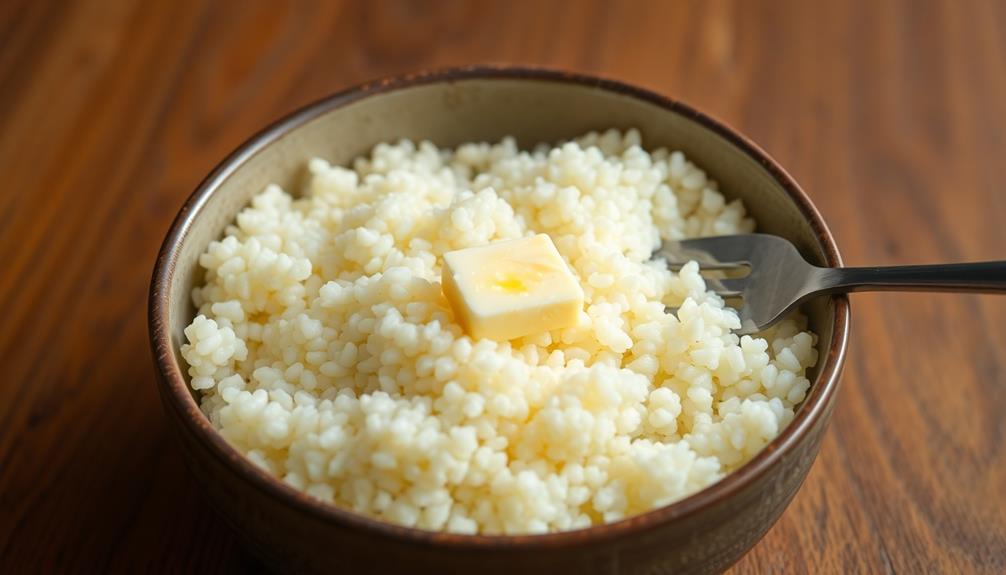
Fluffing the couscous with a fork is the final step in preparing this delectable Moroccan-inspired dish. Grab your trusty fork and gently fluff the fluffy couscous grains, separating them and preventing any clumping.
The gentle motion will aerate the couscous, transforming it into a light and airy texture that's perfect for soaking up the rich, buttery flavor. Picture the couscous grains dancing on your plate, each one distinct and inviting.
Don't be afraid to give it a few good fluffs – the more air you incorporate, the lighter and fluffier the final result will be. This simple step makes all the difference, ensuring your Moroccan Butter Couscous is served with a beautiful, cloud-like consistency.
Fluff, fluff, fluff until you're satisfied, then transfer the couscous to a serving dish and prepare to delight your guests with this aromatic and tempting side.
Final Thoughts
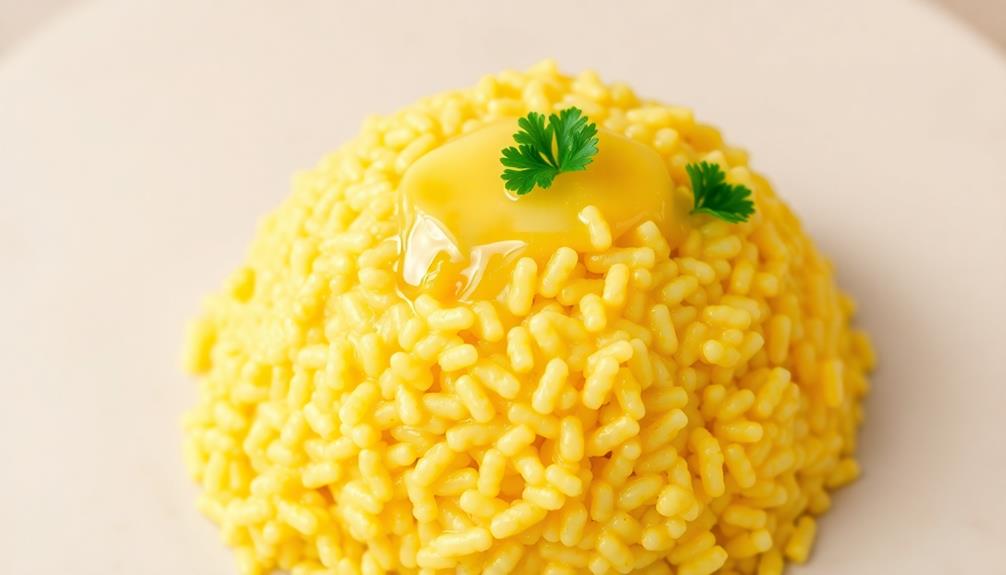
Moroccan Butter Couscous is a delightful and aromatic dish that captures the essence of North African cuisine. The soft, fluffy couscous combined with the rich, creamy butter creates a harmonious balance of flavors and textures.
You'll be delighted by the way the couscous practically melts in your mouth, leaving behind a lingering buttery goodness.
This dish is incredibly versatile, pairing perfectly with a variety of proteins, vegetables, and herbs. Whether you're serving it as a side or as the star of the meal, Moroccan Butter Couscous is sure to impress.
The simple preparation and quick cooking time make it an excellent choice for busy weeknights or when you want to elevate a casual meal.
As you savor each bite, you'll be transported to the vibrant markets of Morocco, where the aroma of spices and the sound of lively conversation fill the air.
Moroccan Butter Couscous is a delightful way to bring a touch of North African flair to your table.
Frequently Asked Questions
Can I Substitute Olive Oil for the Butter?
Absolutely! You can substitute olive oil for the butter in this recipe. The olive oil will provide a different flavor profile, but it'll still result in a light and flavorful couscous dish. Give it a try and see what you think!
How Long Does the Couscous Need to Soak?
You'll typically want to soak the couscous for about 5-10 minutes. This allows the grains to fully absorb the liquid, resulting in a light and fluffy texture. The exact time may vary depending on the type of couscous you're using.
Can I Use Instant Couscous Instead?
Yes, you can use instant couscous instead. It doesn't require the same lengthy soaking time as traditional couscous. Simply follow the package instructions, which typically involve adding boiling water and letting it sit for 5-10 minutes before fluffing with a fork.
Is This Dish Suitable for Vegetarians?
You can certainly make this dish suitable for vegetarians by using a vegetable-based butter or oil instead of traditional butter. This would allow vegetarians to enjoy the light and fluffy couscous without the animal-based ingredient.
Can I Add Any Other Ingredients to the Couscous?
Yes, you can definitely add other ingredients to the couscous! Try stirring in some chopped herbs, roasted veggies, or even dried fruit for extra flavor and texture. Get creative and make it your own!
